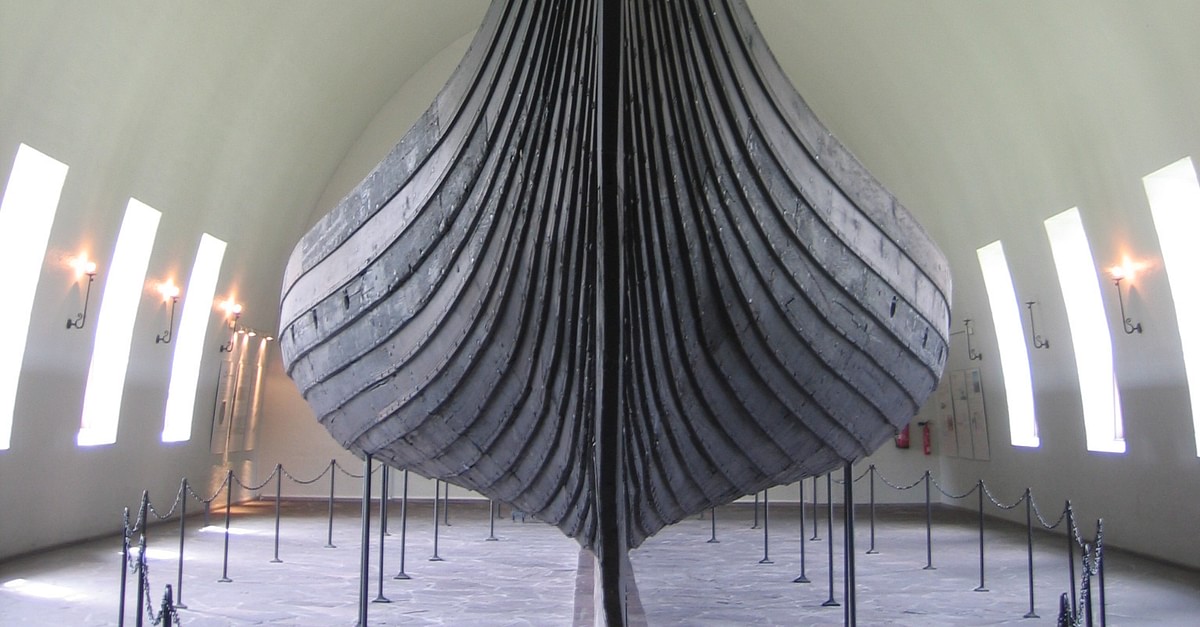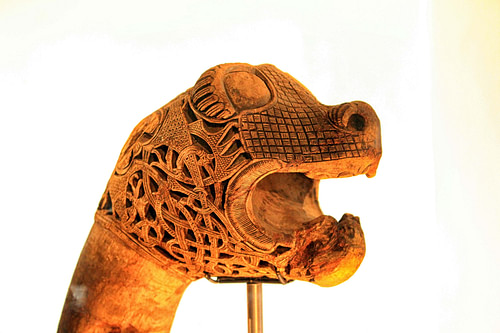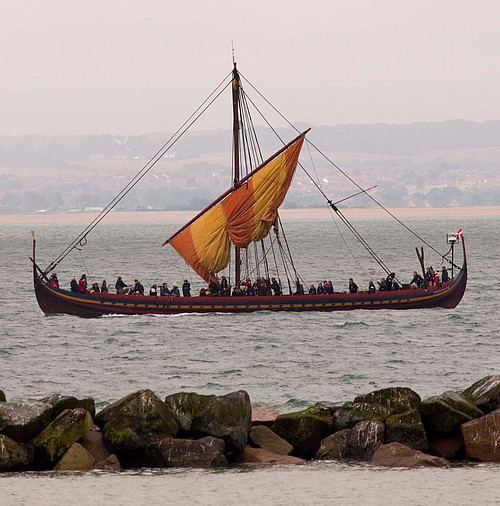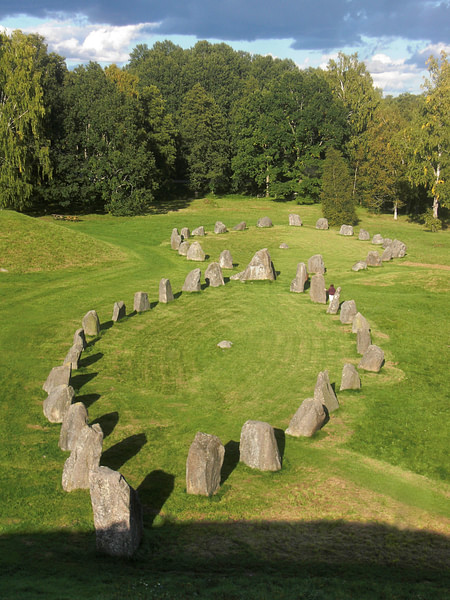
Viking ships have been constructed by the Scandinavians throughout the Viking Age (c. 790 CE – c. 1100 CE) and have been used each inside Scandinavia and past for functions starting from being a very powerful technique of transport to commerce and warfare. Viking growth, furthermore, wouldn’t have been potential with out ships. Probably the most well-known photographs related with the Vikings is that of the dragon-headed longships, red-and-white striped sails giving it lethal velocity and carrying its bloodthirsty warriors to their locations of plunder. Nonetheless, Viking ships got here in many alternative kinds, amongst which there have been big-bellied cargo ships and, certainly, the speedy longships which facilitated raiding and gave the Vikings the sting over their contemporaries, however which removed from at all times had the intricately carved dragon-heads which might be so entrenched in well-liked creativeness. Annoyingly, the archaeological document paints a relatively patchy image, as wooden just isn’t headstrong sufficient to face the check of time very nicely, and our data of early Viking Age ships comes nearly solely from a handful of ship burials, though in a while within the Viking Age sunken ships pop as much as broaden our data a bit.
Origins & development of the traditional Viking ship
Following from the truth that in Scandinavia one can not transfer very far with out having their journey harshly interrupted by rivers, lakes, fjords, numerous straits, and open sea, Scandinavians got here to their senses early on; depictions of ships in stone (in burial settings) and metallic are dated to c. 4000-2300 BCE, connecting with using wood conflict canoes within the Bronze Age.
The addition of sails is what turned Viking ships into the fast & lethal contraptions that turned important to their raiding methods.
The earliest discover we’ve of a plank-built vessel is the 19 meters lengthy, 2-meter huge Hjortspring conflict canoe present in southwest Denmark and relationship to c. 350 BCE. The following large discover is that of the Nydam ships – three boats preserved in a sacrificial deposit in Denmark, the most important of which was round 23,5 meter lengthy and round 3,5 meter huge – which date to c. 350 CE. They used oars as an alternative of the sooner paddles and already showcase the lapstrake (or clinker-built) approach, by which the hull planks overlap; each of those options have been carried on into Viking occasions. Though earlier than the Viking Age most boats had their planks lashed collectively, iron rivets started being utilized by some pioneering shipbuilders as early because the third century CE – one other factor that might grow to be central to Viking ships.
YouTube Comply with us on YouTube! { handlePrimisPlayerRemoval(); },{passive: true}); ]]>
By the point the Viking Age got here across the primary concept behind producing one thing that might not sink on the merest glimpse of water had thus lengthy since taken form. Viking shipbuilders created watertight shells by first laying the keel and stems, then increase overlapping planks riveted to their neighbours (the lapstrake approach) one after the other. This form was then additional stabilised by ribbing which was inserted contained in the planking; this complete sturdy development technique is called shell constructing, and it was the common method of constructing ships all through northern Europe all the way in which till the late Center Ages.
Different options and their results are described by W. W. Fitzhugh:
The addition of oars and sails gave Viking boats a bonus over all different watercraft of their day in velocity, shallow draft, weight, capability, maneuverability, and seaworthiness. Viking boats have been designed to be dragged throughout lengthy portages in addition to to resist fierce ocean storms. Such ships gave the Vikings the power to commerce, make conflict, carry animals, and cross open oceans and on the similar time supplied adequate safety and safety for the crew. (Fitzhugh, 15).
Sails – with out which Viking exploration throughout the ocean would have been profoundly harder – have been truly a relatively new factor that solely (re)appeared in Scandinavia in the direction of the top of the seventh century CE, in all probability on account of elevated mercantile contacts with northern Europe, the place sails have been very a lot in trend. The addition of sails is what turned Viking ships into the fast and lethal contraptions that turned important to their raiding methods.

Oseberg Viking Ship
Vassia Atanassova – Spiritia (CC BY-SA)
Entry to sufficient sturdy timber to foresee within the Vikings’ heavy demand for ships was fortunately not a lot of a difficulty in woodland-covered Scandinavia, though oak – the first-choice decide – didn’t develop within the northern elements, the place pine was used as an alternative. With no saws in sight in northern Europe till the thirteenth century CE, Scandinavian craftsmen created planks by splitting tree trunks that have been in a different way formed relying on the place they have been for use within the ship; ground planks have been deep and slim in the direction of the keel, however broad and flat in the direction of the tops the place extra flexibility was required. Iron, used each for instruments and for fastenings reminiscent of rivets, was additionally so available that even farmers with a good diploma of wealth might supply sufficient supplies and manpower to construct themselves a ship.
Love Historical past?
Join our free weekly e mail publication!
Early varieties of Viking ships
With the Viking raids kicking off simply earlier than 800 CE, we clearly know that by then the Scandinavians have been able to producing seaworthy, crusing vessels. The issue is that many of the ships that date again to this early stage of the Viking Age now appear to embellish our ocean ground or are decayed past recognition. So, when it comes to tangible stays, our picture of Viking ships is visually dominated by the wealthy ship burials containing the Oseberg (c. 834 CE), Gokstad, and Tune (each c. 900 CE) ships present in Oslo fjord in Norway.
The Oseberg ship is the earliest preserved Scandinavian crusing ship and is available in at 21,5 meters lengthy, 5,1 meters broad, with room for 15 pairs of oars; broader (and deeper, too) than as an illustration the slender Nydam ship and the slim longships that would seem in the direction of the top of the tenth century CE. Superbly adorned with wood-carvings, the Oseberg was in all probability related to the lofty tops of society, and though she was seaworthy and has all the principle Viking ship options, she was not but as succesful as later ships. The already way more seaworthy Gokstad was slightly bigger and significantly deeper, and likewise had oarlocks; crusing ships benefited from retaining oar-support, too. Each of those appear to have been pretty strong and all-round vessels that could possibly be utilized in each warfare and for transport functions (probably becoming into the kjóll ship sort). The Tune ship was type of a sized-down model of the Gokstad, with an analogous function.

Oseberg Animal Head
Mike Fay (CC BY)
Nonetheless, extra devoted warships have been additionally round at this time limit, with the time period knarr (or knǫrr, plural knerrir) seemingly indicating early warships with backward-curving stems. Finds such because the small-ish warship from Ladby, Denmark present in a ship burial dated to c. 925 CE, which is decrease, slimmer, and quicker than the Oseberg and Gokstad ships, present that by the top of the ninth century CE specialisation was already occurring all through Scandinavia. The warship’s major function was to not struggle sea-battles (though these did sometimes happen) however relatively to navigate sheltered waters to move its fearsome warrior crew to some extent of curiosity, dropping them off and swiftly selecting them and their loot again up once more when the second got here. Larger-bellied all-rounders, as an alternative, might correctly deal with open waters and will carry each folks – warriors or not – and items.
A visual improve in specialisation
Correctly specialised cargo ships don’t seem in our document (which doesn’t imply they didn’t exist earlier on, nevertheless!) till the tenth century CE, which can also be when warships grow to be longer and extra slender to the purpose they will confidently be referred to as longships and start to look extra continuously than earlier than. Outdated Norse terminology specialises right here, too, with the knarr now hooked up to the brand new cargo ships (which additionally had backward-curving stems, explaining why the time period might carry over), whereas longships have been probably referred to as skeiðar (sing. skeið) in the event that they have been extraordinarily lengthy, serpent- or drakkar ships when dragon-heads have been current, and snekke/snekkjawhen barely smaller.
ON LONG DISTANCES THE VIKINGS TRIED TO ISLAND-HOP OR GET WITHIN SIGHTING RANGE OF KNOWN LANDMARKS, AND RELIED ON THE SUN & STARS, WAVES & WIND, AND CLOUDS & ANIMALS.
Typically seen as one of the vital essential factors of shipbuilding progress within the later Viking Age, cargo ships relied closely on the sail and have been sailable by a small crew whereas having a big carrying capability. The Hedeby ships, as an illustration, that are dated to c. 1025 CE, might need been in a position to maintain as a lot as 60 tons of goodies. Longships, then again, used each oars and sails to achieve their frighteningly excessive speeds which have been so instrumental to the Viking raiders’ hit-and-run techniques. They have been additionally narrower than many of the ships from the early Viking Age; the Viking Ship Museum in Roskilde, Denmark, states that archaeologically, ships should be not less than 5 occasions so long as they have been huge to be labeled as longships. The longest identified longship, often known as Roskilde 6, dates to after 1025 CE and with its staggering size of 36 meters she helps illustrate the truth that longships have been made ever longer throughout the Late Viking Age. In addition to these two subtypes, which remained in use all through the remainder of the Viking Age, there may be loads of indication {that a} load of various, smaller boats would have cluttered up the Scandinavian waterways too.
The 2 sorts mirror modifications in Scandinavian society which befell throughout the tenth century CE. Kingdoms expanded and the ability of kings and chieftains rose, and due to the abundance of water and waterways, political energy was inextricably related with maritime would possibly – which is the place the longships got here in helpful. On the similar time cities grew out of earlier buying and selling centres, taking in ever extra commerce items which all wanted to be profitably transported, not simply near dwelling but additionally to the North Atlantic Viking territories reminiscent of Scotland and Iceland. Folks, cattle, and helpful provides have been clearly additionally not going to swim these distances; devoted, open-sea traversing cargo ships have been clearly very helpful on this regard.

Viking Longship Duplicate
Emma Groeneveld (CC BY)
Navigation
With Viking ships able to scoot throughout any type of distance, it clearly helped if its crew knew the place to go. When staying near the coast, navigation was usually not that a lot of a difficulty, as explanations highlighting landmarks reminiscent of funnily formed cliffs and the period of time between sure factors would normally suffice. The Vikings typically enhanced such options with stone cairns caught on prime of them. Atlantic voyages, nevertheless, the place one might fortunately sail for days with out sighting land in any respect, have been a special matter altogether.
The compass, sea-chart or logs don’t appear to have been identified or utilized in Viking navigation. As an alternative, it appears to be like like, on these lengthy distances, the Vikings tried to island-hop or not less than get inside sighting vary of identified islands functioning as landmarks, whereas data of solar and stars, widespread wave- and wind patterns, the way in which clouds behave over land, and the looks of birds and sea mammals all helped out. The northern skies have been too gentle throughout summertime for stars to be seen, nevertheless, and the solar is clearly not a dependable buddy both: fog might trigger ships to get disoriented at sea. Firsthand expertise on the routes the Vikings sailed was clearly invaluable; one can solely think about the uncertainty a Viking crew will need to have confronted on first-time exploration journeys. Fierce Erik the Crimson, as an illustration, who would famously colonise Greenland, misplaced greater than half of his ships throughout his first journey there, and the remaining ones have been pushed again in the direction of Iceland or wrecked altogether.
Some helpful Viking routes have been, as an illustration, from Denmark to the Mediterranean – a wholly coastal affair; from northern Denmark to England, which took two or three days; from western Norway to Scotland or the Irish sea in all probability by way of the Shetland and Orkney Islands, with solely restricted stretches of open sea; and the true long-haul, open-sea routes from Norway or Eire to Iceland and Greenland. The early 14th-century CE Icelandic Hauksbók manuscript – which incorporates variations of older materials, too – has directions on learn how to get from Norway to Greenland and provides us a good indication of the kinds of methods and experiences the Viking sailors had entry to; the main target lies on a really detailed description which adapts the way in which landmarks assist out coastal navigation to be used on the open seas.

Scandinavian Stone Ship Burial
Achird (CC BY-SA)
Place in society
Ships have been clearly pivotal to Scandinavian society as an entire as in a panorama with so many waterways ships have been utilized in each rung of society, together with the very best; Viking rulers closely trusted ships to achieve (and consequently train management over) all of the nooks and crannies alongside their territories’ shoreline or rivers. These similar waterways furthermore supplied a way more handy method of transporting items and facilitated faster communication than overland, additionally throughout longer distances to abroad settlements.
Culturally, Scandinavian ships burst via the barrier of historical past to stress their significance via the numerous ship burials which were unearthed throughout Scandinavia even starting earlier than the Viking Age. The only type have been graves marked by stones specified by the sample of a ship, however, extra spectacularly, sometimes precise full-fledged ships have been caught into the grave-mounds. Think about a trench with a ship inside it, coated by a mound, with usually not less than one human physique buried inside it, normally in a small chamber amidships or laid out on the deck. An unlimited number of grave items and private possessions, topic to nice regional variation, accompanied the lifeless, and animal sacrifices have been additionally widespread. The Oseberg ship burial – the richest Viking grave ever discovered – as an illustration, contained maybe as a lot as 20 decapitated horses alongside its human occupants: a noblewoman and (in all probability) her handmaid. Typically the vessels have been burnt, although. Macabrely, Viking ship burials, particularly, appear to be related with human sacrifice, as seen in lots of ship-related graves containing individuals who had been intentionally killed (as evidenced by their decapitation, stabbing, damaged necks, and many others.) to tag together with the grave’s major occupant.
After all, Viking growth and abroad affect would by no means have been potential with out technologically sound ships. Merely when it comes to exploration and colonisation, their ships allowed the Vikings to achieve and settle within the British Isles, Iceland, Greenland, via the Mediterranean, and even throughout to Newfoundland in North America (‘Vinland’). The velocity and agility of their vessels turned their fast hit-and-run techniques into a giant hit, thus enjoying a key function in warfare, too – the choice of oars and their shallow draft permitting the ships to drop its crew off nearly anyplace, even near nearly landlocked targets reminiscent of Paris. This, then, is the place the nightmare-image of dragon-heads descending upon unprepared targets will need to have actually come alive for the Vikings’ victims.
This text has been reviewed for accuracy, reliability and adherence to educational requirements previous to publication.